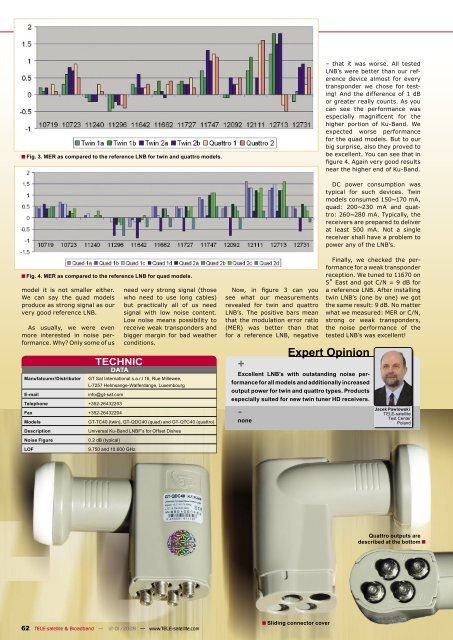_default _116_pages.indd - TELE-satellite International Magazine
_default _116_pages.indd - TELE-satellite International Magazine
_default _116_pages.indd - TELE-satellite International Magazine
You also want an ePaper? Increase the reach of your titles
YUMPU automatically turns print PDFs into web optimized ePapers that Google loves.
■<br />
■<br />
Fig. 3. MER as compared to the reference LNB for twin and quattro models.<br />
Fig. 4. MER as compared to the reference LNB for quad models.<br />
model it is not smaller either.<br />
We can say the quad models<br />
produce as strong signal as our<br />
very good reference LNB.<br />
As usually, we were even<br />
more interested in noise performance.<br />
Why? Only some of us<br />
TECHNIC<br />
DATA<br />
need very strong signal (those<br />
who need to use long cables)<br />
but practically all of us need<br />
signal with low noise content.<br />
Low noise means possibility to<br />
receive weak transponders and<br />
bigger margin for bad weather<br />
conditions.<br />
Manufatcurer/Distributor GT Sat <strong>International</strong> s.a.r.l 16, Rue Millewee,<br />
L-7257 Helmsange-Walferdange, Luxembourg<br />
E-mail info@gt-sat.com<br />
Telephone +352-26432203<br />
Fax +352-26432204<br />
Models GT-TC40 (twin), GT-QDC40 (quad) and GT-QTC40 (quattro)<br />
Description Universal Ku-Band LNBF’s for Offset Dishes<br />
Noise Figure 0.2 dB (typical)<br />
LOF 9.750 and 10.600 GHz<br />
62 <strong>TELE</strong>-<strong>satellite</strong> & Broadband — 12-01/2009 — www.<strong>TELE</strong>-<strong>satellite</strong>.com<br />
Now, in figure 3 can you<br />
see what our measurements<br />
revealed for twin and quattro<br />
LNB’s. The positive bars mean<br />
that the modulation error ratio<br />
(MER) was better than that<br />
for a reference LNB, negative<br />
■<br />
Expert Opinion<br />
+<br />
Excellent LNB’s with outstanding noise performance<br />
for all models and additionally increased<br />
output power for twin and quattro types. Products<br />
especially suited for new twin tuner HD receivers.<br />
-<br />
none<br />
Sliding connector cover<br />
– that it was worse. All tested<br />
LNB’s were better than our reference<br />
device almost for every<br />
transponder we chose for testing!<br />
And the difference of 1 dB<br />
or greater really counts. As you<br />
can see the performance was<br />
especially magnificent for the<br />
higher portion of Ku-Band. We<br />
expected worse performance<br />
for the quad models. But to our<br />
big surprise, also they proved to<br />
be excellent. You can see that in<br />
figure 4. Again very good results<br />
near the higher end of Ku-Band.<br />
DC power consumption was<br />
typical for such devices. Twin<br />
models consumed 150~170 mA,<br />
quad: 200~230 mA and quattro:<br />
260~280 mA. Typically, the<br />
receivers are prepared to deliver<br />
at least 500 mA. Not a single<br />
receiver shall have a problem to<br />
power any of the LNB’s.<br />
Finally, we checked the performance<br />
for a weak transponder<br />
reception. We tuned to <strong>116</strong>70 on<br />
5˚ East and got C/N = 9 dB for<br />
a reference LNB. After installing<br />
twin LNB’s (one by one) we got<br />
the same result: 9 dB. No matter<br />
what we measured: MER or C/N,<br />
strong or weak transponders,<br />
the noise performance of the<br />
tested LNB’s was excellent!<br />
Jacek Pawlowski<br />
<strong>TELE</strong>-<strong>satellite</strong><br />
Test Center<br />
Poland<br />
Quattro outputs are<br />
described at the bottom<br />
■

















